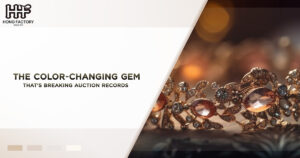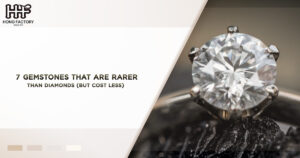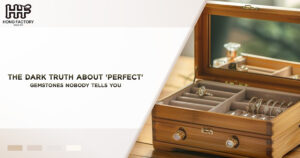When it comes to gemstones, perfection often seems synonymous with value. Many people mistakenly believe that only flawless stones hold worth in the market, but this couldn’t be further from the truth. In fact, some “flawed” gemstones are not only captivating but also highly sought after, fetching incredible prices due to their unique imperfections. These natural quirks make certain gems one-of-a-kind treasures and are the key to their extraordinary value.
In this article, we’ll explore five flawed gems that defy traditional beauty standards and explain how their imperfections contribute to their worth. Whether you’re a gem enthusiast, a collector, or simply curious about how nature’s quirks can elevate value, keep reading to uncover the fascinating truth behind these natural marvels.
What Makes a Gemstone Valuable?
Before diving into the specific gemstones, it’s important to understand the factors that determine a gem’s value. Traditionally, gemstones are assessed using the “Four Cs” :
- Cut – Refers to the precision and artistry of how the gem is shaped.
- Clarity – Indicates the number of visible imperfections or inclusions.
- Color – Measures the hue, tone, and saturation of the stone.
- Carat Weight – Refers to the size and weight of the gem.
While clarity typically emphasizes flawlessness, there are exceptions where imperfections—such as unique inclusions, natural blemishes, or unusual formations—actually contribute to a gem’s rarity and desirability. These “flawed” gems shatter conventional wisdom, proving that beauty is not always about perfection.
The Beauty of Natural Imperfections
Natural imperfections often tell the story of a gemstone’s formation over millions of years. These flaws, known as inclusions, can take many forms: internal fractures, trapped minerals, or even gas bubbles. In some cases, these imperfections create breathtaking patterns or optical effects that enhance a gem’s uniqueness.
Let’s now take a closer look at five ‘flawed’ gemstones that are actually worth a fortune.
1. Emeralds – Beauty in Their “Jardin”
What Are Emerald Inclusions?
Emeralds are prized for their lush green hue, but their value doesn’t necessarily hinge on flawless clarity. Most emeralds are naturally riddled with inclusions, sometimes referred to as the stone’s “jardin” (French for “garden”). These inclusions often appear as tiny fractures or mineral streaks within the gem.
Why Flaws Make Emeralds Valuable
Instead of detracting from their beauty, the jardin in emeralds is considered a hallmark of authenticity. Synthetic emeralds, for example, are often too perfect and lack these natural imperfections, making them less desirable to collectors. High-quality emeralds with vibrant color and visible inclusions can still fetch astronomical prices.
Fun Fact
The Rockefeller Emerald, an 18.04-carat emerald with visible inclusions, sold for $5.5 million at auction in 2017, despite its imperfections.
2. Star Sapphires – Radiance from Rutile Inclusions
What Is Asterism?
Star sapphires are a perfect example of how inclusions can enhance a gemstone’s appeal. These stones exhibit a phenomenon called asterism, where a star-like pattern appears on the surface of the gem when light reflects off needle-like inclusions of rutile (a mineral composed of titanium dioxide).
The Value of Star Sapphires
The alignment of these rutile inclusions is what creates the mesmerizing star effect, making the gem unique and highly valuable. The rarest star sapphires feature a sharp, well-centered star with six or twelve rays.
Key Example :
The Star of India, one of the largest star sapphires in the world, is valued not just for its size but also for the stunning asterism caused by its natural imperfections.
3. Amber – Fossilized Flaws That Captivate Collectors
What Makes Amber Special?
Amber is not a gemstone in the traditional sense—it’s fossilized tree resin. What sets amber apart and increases its value are the inclusions trapped within it. These inclusions can range from air bubbles to prehistoric plant material, and even ancient insects.
Why Imperfections Enhance Amber’s Value
Amber with well-preserved inclusions, such as a perfectly intact insect, is highly prized by collectors and scientists. These natural imperfections offer a window into Earth’s prehistoric past, making each piece of amber completely unique.
Record-Breaking Sale:
In 2016, a piece of amber containing a 99-million-year-old dinosaur tail was sold for $1.2 million, proving that imperfections can truly be priceless.
4. Rutilated Quartz – Striking Patterns from Needle-Like Inclusions
What Are Rutile Inclusions?
Rutilated quartz is a type of quartz that contains needle-like inclusions of rutile, which can appear in golden, copper, or silver hues. These inclusions form intricate, web-like patterns that make each stone visually stunning.
Why Rutilated Quartz Is Valuable
The value of rutilated quartz lies in the beauty and symmetry of its inclusions. Stones with well-defined, evenly distributed rutile needles are particularly prized. No two pieces of rutilated quartz are the same, making them a favorite among collectors and jewelry designers.
Did You Know?
Rutilated quartz is often called “Venus’ Hair Stone” because its golden inclusions resemble strands of hair.
5. Opals – Nature’s Canvas of Colors
The Role of Imperfections in Opals
Opals are known for their dazzling play-of-color, which is caused by microscopic silica spheres within the stone. While opals are often graded based on the consistency of their color pattern, some imperfections—such as cracks or uneven color distribution—can create unique, one-of-a-kind designs.
Why Unique Opals Are Highly Prized
Collectors often seek out opals with unusual color patterns or rare hues, such as black opals or fire opals. Even “imperfect” opals with irregular patterns can command high prices due to their individuality and natural artistry.
A Legendary Example:
The “Aurora Australis,” a 180-carat black opal, broke records at auction thanks to its vibrant play-of-color and unique imperfections.
The Key to Gem Value – Uniqueness
As we’ve seen, imperfections in gemstones can sometimes elevate their value rather than diminish it. These flaws tell a story, add character, and make each gem entirely unique. For collectors, uniqueness often outweighs traditional standards of perfection.
How to Choose “Flawed” Gems
If you’re considering investing in gemstones with natural imperfections, here are some tips :
- Focus on Rarity – Look for gems with rare types of inclusions or phenomena.
- Consider Aesthetics – Choose stones where the imperfections enhance their visual appeal.
- Get Certification – Always ensure the gem comes with a certificate of authenticity to verify its value.
- Work with Experts – Consult with gemologists or reputable dealers to understand the market value of unique stones.
Conclusion
Flawed gems challenge our preconceived notions of beauty and value. From the intricate jardin of emeralds to the ancient inclusions in amber, these imperfections make each gemstone a masterpiece of nature. While traditional metrics like clarity and cut are important, unique flaws often tell a story that resonates with collectors, making these gems worth a fortune.
So, the next time you admire a gemstone, remember: perfection isn’t everything. Sometimes, it’s the flaws that make a gem truly priceless.
By celebrating the beauty of natural imperfections, we not only broaden our understanding of gemology but also gain a deeper appreciation for the artistry of nature. Whether you’re a collector or a casual admirer, these “flawed” gems are a testament to the fact that there’s value in embracing imperfections—both in gemstones and in life.




